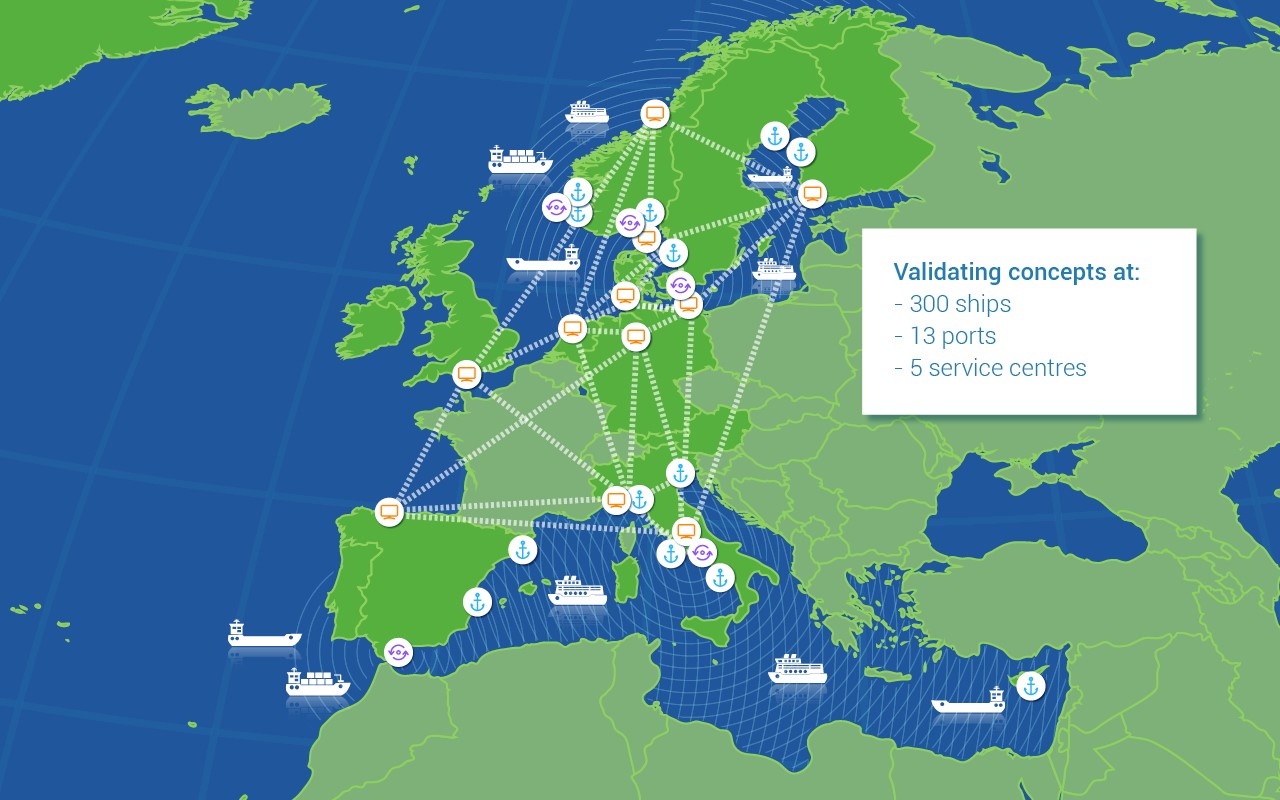STM Validation

Preliminary matters
- Name of testbed: STM Validation (STM = Sea Traffic Management) (Tagline: Seaing is believing!)
- Location of testbed: Northern Europe, the Mediterranean, Digitally
- Time and duration of testbed: 2015-2018
- Status (planned, completed or on-going): On-going
- Contact person(s): Magnus Sundström (Project Leader) magnus.sundstrom@sjofartsverket.se , Ulf Siwe (Communications Officer) ulf.siwe@sjofartsverket.se
- Testbed website: www.stmvalidation.eu
- Organisation(s) involved: Partners: Swedish Maritime Adminstration (Project Coordinator), Carnival Sorporation, Chalmers University of Technology, CIMNE, Costa Crociere, Cyprus University of Technology, Danish Maritime Authority, Finnish Transport Agency, Flensburg University of Applied Sciences, Fraunhofer, Frequentis, Furuno, GS1, HiQ, Magellan, Maritiem Instituut Willem Barentsz, Ministry of Infrastructure and Transport in Italy, Navicon, Norwegian Coastal Administration, Novia University of Applied Sciences, OFFIS, Polytechnical University of Catalonia, Port Authority of Valencia, Port of Barcelona, Rörvik Maritime Safety Centre, SAAB, SASEMAR, Signalis, Southampton Solent University, SSPA, Svitzer, Swedish Meteorological and Hydrological Institute, TRANSAS, University of Oldenburg, University of Southampton, Valenicaport Foundation, Viktoria Swedish ICT, Wärtsilä SAM Electronics Associate Partners: Adveto, BIMCO, Carmenta, Cygate, Ericsson, Fleet Management Limited, Fleetrange, inPort, Janz Tec, Kongsberg, Kvarken Ports, Navtor, PortCall.com, port of Gothenburg, Raytheon, Rheinmetall, SEAMLESS, SSAB, Tototheo Group, UK Hydrographic Office, University of Applied Sciences Emden Leer (and joining ongoing, please see the web site for latest)
- Funding programme and budget: EU CEF
Related projects: MONALISA, MONALISA 2.0, ACCSEAS, EfficienSea2, SESAME Strait,
Executive summary
Sea Traffic Management, STM, is an initiative to establish standardised information sharing with open interfaces. It is designed to make winners of all actors in the maritime transport chain. More efficient routing can save billions of euros in reduced bunker cost and emissions. By adjusting arrivals to port availability and taking steps towards just-in-time-processes, more fuel is saved and fewer emissions are released overall, which is particularly important in coastal areas. Information sharing will also reduce the number of collisions and groundings by more than 60%, leading to obvious savings for ship-owners and insurance companies. Moreover, a decrease in the number of collisions and groundings also means a reduction of the public cost for decontamination.
STM Validation encompasses five operational activities, all of which contribute to improving the safety, environmental performance and efficiency of maritime transport. The main objectives are to strengthen the efficiency, capacity, flexibility, predictability, security, safety and the environmental performance of maritime transport, while simultaneously reducing the administrative burden of the maritime sector.
In STM Validation, the results and definitions from the previous projects (MONALISA and MONALISA 2.0, as well as other related project like ACCSEAS, EfficiensSea2, etc.) will be validated through joint actions by:
- concrete applications and services, some that are provided by commercial actors enhancing maritime safety and increasing the efficiency
- using the route exchange standard and working on a port call message standard in collaboration with providers of global logistics standards
- making Search and Rescue more efficient than is currently the case
- simulating complex traffic situations with and without STM services validating the added value
- developing and using the maritime service infrastructure SeaSWIM with the Maritime Cloud as an underlying infrastructure
Activity 1: Validation of Port Collaborative Decision Making (Port CDM)
Expanding the network of ports and Port CDM services developed in MONALISA 2.0 in the Nordic and Mediterranean regions. The contextual differences between port approaches will be gathered and analysed, and will serve as a basis for the concept’s refinement. The test beds will also be the first step towards involving both commercial and public service developers/distributors in building Port CDM Services.
Activity 2: Validation of Voyage Management
will be executed in two test beds, one in the Mediterranean and one in the Nordic region. In the latter STM services for more efficient winter navigation and crisis management (i.e. Search and Rescue) will be tested and validated.
Activity 3: Validation of Flow Management
utilising the European Maritime Simulator Network and the test beds for Voyage Management. This simulator network was developed within the MONALISA 2.0 project and will be used both to simulate varying traffic conditions and further test and validate other parts of STM that are not possible to test and validate in real life at this stage, such as area management.
Activity 4: Validation of common Maritime Service Infrastructure
System Wide Information Management (SeaSWIM) and the Maritime Cloud as the infrastructure for information exchange in the validation test beds. Standardised information exchange is the heart of STM.
Activity 5: Analysis and Evaluation
will cover many aspects of the future changes: business, socio-economic, risk, technological, legal and institutional. Competencies and training requirements for STM implementation will also be considered. Reporting will be in line with the IMO and IALA test bed guidelines.
Relevant documents
STM Validation project description
Recruitment of 300 ships
Adveto, Transas & Wärtsilä SAM Electronics
Furuno
SeaSWIM Requirements
Port Call Message Standard
Videos
STM – the concept
STM – Services and benefits
STM – Services in Practice
STM – Port Collaborative Decision Making (PortCDM)
STM – European Maritime Simulator Network


